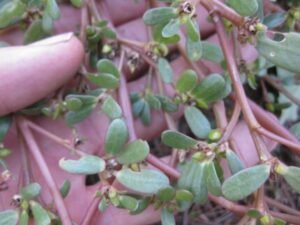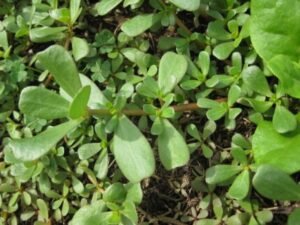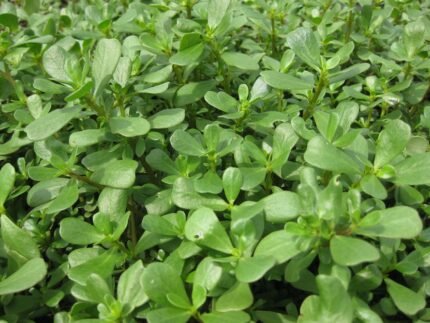Medically reviewed by Dr. Ramesh Gaddam, M.D. — Written by Sumalatha, D.N.H.E
Health Benefits
Purslane offers several health benefits due to its nutritional content.
Here are some of the key benefits:

Rich in Nutrients
Purslane is packed with vitamins, minerals, and antioxidants.
It’s particularly high in vitamins A, C, and E, as well as minerals like calcium, magnesium, and potassium.
Heart Health
The high levels of omega-3 fatty acids found in purslane may help reduce the risk of heart disease by lowering levels of LDL (bad) cholesterol and triglycerides, and increasing HDL (good) cholesterol.
Anti-inflammatory Properties
Purslane contains compounds like alpha-linolenic acid and betalain pigments, which have anti-inflammatory properties.
These may help reduce inflammation in the body and alleviate symptoms of inflammatory conditions such as arthritis.
Improved Digestive Health
The fiber content in purslane can promote healthy digestion by preventing constipation, improving bowel regularity, and supporting gut health.
Boosts Immunity
The high vitamin C content in purslane can help strengthen the immune system, protecting against common illnesses like colds and flu.
Antioxidant Activity
Purslane contains various antioxidants, such as vitamin C and flavonoids, which help neutralize harmful free radicals in the body, reducing oxidative stress and lowering the risk of chronic diseases.
Bone Health
Purslane is a good source of calcium, magnesium, and vitamin C, all of which are essential for maintaining healthy bones and preventing conditions like osteoporosis.
Weight Management
Purslane is low in calories and carbohydrates while being high in fiber, which can help you feel full and satisfied, potentially aiding in weight management.
Skin Health
The vitamins A, C, and E in purslane contribute to skin health by promoting collagen production, protecting against sun damage, and reducing the signs of aging.
Uses of Purslane
Purslane has a variety of uses, both culinary and non-culinary. Here are some of the common uses:

Culinary Uses:
|
Pickling:
Purslane can be pickled and preserved for later use. It adds a unique flavor to pickled dishes.
Medicinal Uses:
|
Livestock Feed
Purslane is often used as fodder for livestock, as it’s nutritious and readily available.
Companion Planting
Purslane can be grown alongside other crops to help suppress weeds and conserve soil moisture.
Ornamental Plant
Some varieties of purslane are grown as ornamental plants for their attractive foliage and colorful flowers.
Green Manure
Purslane can be grown as a cover crop and then turned into the soil to improve soil fertility.
Natural Dye
Purslane can be used as a natural dye for textiles and fibers, producing colors ranging from yellow to red.
Habitat for Beneficial Insects
Purslane can attract beneficial insects such as pollinators to your garden.
Side Effects
While purslane is generally safe for consumption and offers various health benefits, there are a few considerations to keep in mind:

Potential Oxalate Content
Purslane contains oxalates, which in high amounts can contribute to the formation of kidney stones in susceptible individuals.
If you have a history of kidney stones or are prone to them, it’s advisable to consume purslane in moderation.
Allergic Reactions
Some individuals may be allergic to purslane, although such cases are rare.
Allergic reactions may include itching, skin irritation, or gastrointestinal discomfort.
If you experience any adverse reactions after consuming purslane, discontinue use and consult a healthcare professional.
Interactions with Medications
Purslane may interact with certain medications.
For example, it can lower blood sugar levels, so individuals taking medication for diabetes should monitor their blood sugar closely if consuming purslane regularly.
Additionally, purslane may have a mild blood-thinning effect, so it’s important to exercise caution if you’re taking anticoagulant medications.
Pesticide Residue
If harvested from non-organic sources or areas treated with pesticides, purslane may contain pesticide residues.
Washing thoroughly before consumption can help reduce the risk, or opting for organically grown purslane can minimize exposure to pesticides.
Gastrointestinal Upset
Some people may experience digestive issues such as bloating, gas, or diarrhea when consuming purslane, particularly if they’re not accustomed to eating high-fiber foods.
Gradually introducing purslane into your diet and ensuring adequate hydration can help mitigate these effects.
Purslane Health Benefits for Skin
Purslane offers several health benefits for the skin, primarily due to its rich nutritional profile and antioxidant properties:

Antioxidant Protection
Purslane contains antioxidants like vitamins A, C, and E, as well as flavonoids, which help protect the skin from damage caused by free radicals.
Free radicals can contribute to premature aging, such as wrinkles, fine lines, and age spots.
Collagen Production
Vitamin C, present in purslane, plays a crucial role in collagen synthesis.
Collagen is a protein that provides structure and elasticity to the skin.
Consuming purslane or applying it topically may help promote collagen production, leading to firmer, more youthful-looking skin.
Sun Protection
The antioxidants in purslane can also help protect the skin from damage caused by UV radiation.
While not a replacement for sunscreen, incorporating purslane into your diet or skincare routine may provide an additional layer of defense against sun damage.
Anti-inflammatory Effects
Purslane contains compounds with anti-inflammatory properties, which can help soothe irritated or inflamed skin.
This can be particularly beneficial for conditions such as acne, eczema, or rosacea.
Moisturizing
Purslane contains mucilage, a gel-like substance that can help hydrate the skin and lock in moisture.
Using purslane-based skincare products or applying purslane topically may help improve skin hydration and prevent dryness.
Wound Healing
Some studies suggest that purslane may aid in wound healing due to its antibacterial and anti-inflammatory properties.
Applying purslane extract or poultices to minor wounds or cuts may promote faster healing and reduce the risk of infection.
Reduction of Hyperpigmentation
The vitamin A content in purslane may help reduce hyperpigmentation and dark spots by promoting cell turnover and regulating melanin production.
Anti-Aging Effects
Regular consumption or application of purslane may help reduce the appearance of wrinkles and fine lines, promoting a more youthful complexion over time.
Purslane Benefits for Liver
Purslane offers several potential benefits for liver health, primarily due to its antioxidant, anti-inflammatory, and nutrient-rich properties:

Detoxification
Purslane contains antioxidants such as vitamins A, C, and E, as well as glutathione, which help the liver in its detoxification processes.
These antioxidants neutralize harmful free radicals and toxins, reducing the burden on the liver.
Anti-inflammatory Effects
Chronic inflammation can contribute to liver damage and disease.
Purslane contains compounds with anti-inflammatory properties that may help reduce inflammation in the liver and protect against conditions like non-alcoholic fatty liver disease (NAFLD) and liver fibrosis.
Liver Protection
Studies suggest that certain compounds found in purslane, such as flavonoids and betalain pigments, may have protective effects on the liver.
They can help prevent liver damage caused by toxins, alcohol, and other harmful substances.
Antioxidant Support
Purslane is rich in antioxidants that scavenge free radicals, preventing oxidative stress in the liver.
This oxidative stress can lead to liver cell damage and contribute to the development of liver diseases.
Regulation of Lipid Metabolism
Purslane may help regulate lipid metabolism, which is essential for liver health.
It can help reduce levels of triglycerides and cholesterol in the blood, which can contribute to the development of fatty liver disease.
Improvement of Liver Function
Some research suggests that purslane may improve liver function by enhancing the activity of liver enzymes involved in detoxification and metabolism.
Prevention of Liver Fat Accumulation
Purslane consumption may help prevent the accumulation of fat in the liver, a condition known as hepatic steatosis or fatty liver.
This is particularly relevant for individuals with obesity or metabolic syndrome.
Support for Liver Regeneration
Certain compounds in purslane, such as polysaccharides, may support liver regeneration and repair damaged liver tissue.
Purslane Tea Benefits
Purslane tea, made from the leaves and stems of the purslane plant, offers several potential health benefits:

Antioxidant Properties
Purslane tea is rich in antioxidants, including vitamins A, C, and E, as well as flavonoids and betalain pigments.
These antioxidants help neutralize harmful free radicals in the body, protecting cells from damage and reducing the risk of chronic diseases such as cancer and heart disease.
Anti-inflammatory Effects
Compounds found in purslane, such as alpha-linolenic acid and betalain pigments, have been shown to have anti-inflammatory properties.
Drinking purslane tea may help reduce inflammation in the body, alleviating symptoms of inflammatory conditions such as arthritis and promoting overall health.
Digestive Health
Purslane tea contains dietary fiber, which can help promote healthy digestion by supporting regular bowel movements and preventing constipation.
It may also help soothe the digestive tract and reduce symptoms of gastrointestinal discomfort.
Heart Health
The omega-3 fatty acids found in purslane tea may help lower cholesterol levels and reduce the risk of heart disease.
Additionally, the tea’s antioxidant and anti-inflammatory properties can help support cardiovascular health by protecting blood vessels and reducing inflammation in the arteries.
Weight Management
Purslane tea is low in calories and may help promote weight loss or weight management when consumed as part of a balanced diet and healthy lifestyle.
Its fiber content can help you feel fuller for longer, reducing cravings and overall calorie intake.
Liver Support
Some research suggests that purslane tea may support liver health by promoting detoxification and protecting against liver damage caused by toxins and oxidative stress.
Kidney Health
Purslane tea has diuretic properties, meaning it can increase urine production.
This may help support kidney function by promoting the elimination of waste products and toxins from the body.
Skin Benefits
Drinking purslane tea may contribute to healthier skin due to its antioxidant content.
It can help protect against sun damage, reduce inflammation, and promote collagen production, leading to a more youthful complexion.
Frequently Asked Questions
Users frequently searched for queries about purslane:
Who should not eat purslane?
While purslane is generally safe for consumption, individuals who are allergic to purslane or other similar plants should avoid it.
Additionally, people with a history of kidney stones should consume purslane in moderation due to its oxalate content, which can exacerbate the condition.
Is purslane better raw or cooked?
Both raw and cooked purslane have their benefits.
Raw purslane retains more of its nutrients, including vitamin C and omega-3 fatty acids.
However, some people prefer cooked purslane for its milder flavor and softer texture.
Cooking can also help break down oxalates, making it easier for people with kidney stone issues to consume.
Does purslane have side effects?
While purslane is generally safe, some individuals may experience allergic reactions, digestive upset, or interactions with medications.
Additionally, consuming large amounts of purslane may increase the risk of kidney stone formation in susceptible individuals.
How much purslane should I eat a day?
There’s no specific recommendation for daily purslane intake.
Moderation is key, and incorporating small amounts into your diet as part of a balanced meal plan is advisable.
Is purslane good for kidneys?
Purslane may have benefits for kidney health due to its diuretic properties, which can help promote urine production and support kidney function.
However, individuals with kidney stones should consume purslane in moderation due to its oxalate content.
Is purslane better than spinach?
Purslane and spinach are both nutritious leafy greens, but they have different nutritional profiles.
Purslane is higher in omega-3 fatty acids, vitamin E, and certain minerals like potassium and magnesium compared to spinach.
What is the best way to eat purslane?
Purslane can be eaten raw in salads, added to soups, stir-fries, or sautéed with other vegetables, or used as a garnish.
It can also be pickled or blended into smoothies for added nutrition.
Is purslane a superfood?
Purslane is often considered a superfood due to its high nutritional content, including vitamins, minerals, antioxidants, and omega-3 fatty acids.
Is purslane anti-aging?
The antioxidants and vitamins in purslane may help protect the skin from damage caused by free radicals, contributing to a more youthful appearance.
What is the secret of purslane?
The secret of purslane lies in its nutritional density and versatility.
It’s packed with nutrients and can be incorporated into a wide range of dishes to boost overall health.
What is purslane in Ayurveda?
In Ayurveda, purslane is considered cooling and detoxifying.
It’s used to balance Pitta and Kapha doshas and is believed to have benefits for digestion, inflammation, and skin health.
Can diabetics eat purslane?
Purslane may have benefits for individuals with diabetes due to its low glycemic index and potential to improve blood sugar control.
However, people with diabetes should monitor their blood sugar levels closely when incorporating new foods into their diet.
Is there vitamin E in purslane?
Yes, purslane contains vitamin E, which is an antioxidant that helps protect cells from damage and supports immune function.
Is purslane good for arthritis?
The anti-inflammatory properties of purslane may help reduce inflammation and alleviate symptoms of arthritis.
However, more research is needed to confirm its effectiveness for this purpose.
Is purslane high in calcium?
Yes, purslane is relatively high in calcium compared to other leafy greens, making it a good choice for individuals looking to increase their calcium intake.
What is another name for purslane?
Another name for purslane is “Portulaca oleracea.”
It is also known by various other names in different regions, including pigweed, verdolaga, and little hogweed.
Is purslane good for hair growth?
Purslane contains vitamins and minerals that may support hair health, such as vitamin E, vitamin C, and omega-3 fatty acids.
While there’s limited direct evidence, the nutrients in purslane may contribute to overall hair health, but more research is needed specifically on its effect on hair growth.
Is too much purslane bad?
Consuming too much purslane may lead to potential side effects, such as digestive upset or interactions with medications.
Additionally, excessive consumption of oxalate-rich foods like purslane may increase the risk of kidney stone formation in susceptible individuals.
Can I eat purslane raw?
Yes, purslane can be eaten raw.
Its succulent leaves and stems are often added to salads, sandwiches, or eaten as a snack.
What product kills purslane?
Various herbicides are available for killing purslane, but they may also harm other plants in the vicinity.
Non-chemical methods include hand-pulling or mulching to suppress purslane growth.
When should I eat purslane?
Purslane can be eaten at any time of day as part of a balanced meal.
It can be incorporated into breakfast, lunch, or dinner dishes, or enjoyed as a snack.
Do you eat purslane stems?
Yes, both the leaves and stems of purslane are edible.
The stems are tender and can be eaten raw or cooked along with the leaves.
Is purslane good for the liver?
Purslane may have benefits for liver health due to its antioxidant and anti-inflammatory properties.
It may help support liver function and protect against liver damage caused by toxins or oxidative stress.
Is purslane good cooked?
Yes, purslane can be cooked in various ways, such as sautéing, stir-frying, steaming, or boiling.
Cooking purslane can help soften its texture and mellow its flavor.
Medically reviewed by Dr. Ramesh Gaddam, M.D.

General Physician, Diabetologist, and Critical Care Specialist.
Discover more from Health Build-Up
Subscribe to get the latest posts sent to your email.

1 thought on “10 Health Benefits of Purslane for Skin, Liver and More”
Comments are closed.